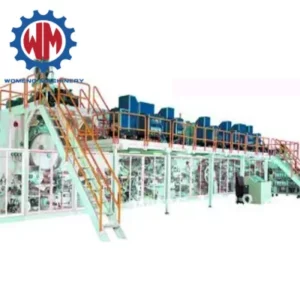Quality control and defect detection are crucial aspects of adult diaper manufacturing, and they’re integrated into the operation of the machine through various methods:
- Sensors and Vision Systems: Advanced sensors and vision systems are employed at different stages of the production process. These systems scan and inspect diapers for defects, irregularities, or deviations from specified parameters. They detect issues in size, shape, elasticity, adhesive placement, and overall product integrity.
- Automated Inspection Stations: Dedicated inspection stations within the diaper machine allow for comprehensive examination of diapers as they move through the production line. These stations use sensors, cameras, or laser systems to identify defects or inconsistencies.
- Real-time Monitoring: Sensors continuously monitor critical parameters such as material thickness, tension, moisture content, and dimensions. Any deviations from preset standards trigger immediate corrective actions or alerts, ensuring consistent quality.
- Defect Rejection Systems: Automated defect detection systems integrated into the machine can sort out or reject diapers that do not meet quality standards. This prevents defective products from progressing through the production process, minimizing waste.
- Statistical Process Control (SPC): SPC techniques are employed to monitor and analyze data collected during production. Statistical tools help identify trends, variations, or patterns in quality metrics, allowing for continuous process improvement and defect prevention.
- Machine Learning and AI: Some advanced systems use machine learning algorithms or artificial intelligence to analyze patterns in defects. This technology can improve over time, becoming more accurate in identifying and addressing potential issues.
- Barcode or RFID Tracking: Each diaper might be tagged with a barcode or RFID (Radio-Frequency Identification) tag. This enables tracking and traceability throughout the manufacturing process, aiding in identifying and addressing defects.
- User Interface and Control Systems: Diaper machine control systems provide user-friendly interfaces for operators to monitor quality metrics, view inspection results, and intervene if necessary.
- Sampling and Testing: Random sampling and testing of diapers from the production line verify quality standards. Any deviations prompt adjustments or fine-tuning of machine settings to maintain consistency.
By integrating these quality control measures directly into the operation of the adult diaper machine, manufacturers ensure that only high-quality products meeting stringent standards are produced, minimizing defects and ensuring customer satisfaction.
How is the functionality of a adult diaper machine tested and validated before full-scale production?
Testing and validating the functionality of an adult diaper machine before full-scale production involves a series of rigorous steps to ensure its performance, reliability, and capability to produce high-quality diapers. Here’s an overview of the process:
- Design Verification: Engineers conduct design reviews and simulations to validate the machine’s design against specifications and intended functionalities. Computer-aided design (CAD) models and simulations predict how the machine will perform under different conditions.
- Prototype Development: A prototype or pilot-scale version of the machine is built to test its functionalities on a smaller scale. This prototype is subjected to initial testing to assess its performance and identify any design flaws or inefficiencies.
- Functional Testing: Each component and subsystem of the machine undergoes functional testing. This includes testing the material handling systems, cutting mechanisms, shaping processes, adhesive application, and any other critical functionalities.
- Performance Evaluation: Engineers test the machine’s performance by running production trials using actual materials. adult diaper machine suppliers They assess its speed, accuracy in producing different diaper sizes and configurations, waste minimization, and overall output quality.
- Quality Control Trials: The machine undergoes trials specifically focused on quality control mechanisms. Sensors, vision systems, and defect detection systems are thoroughly tested to ensure they can identify and address potential issues in real-time.
- Reliability and Durability Testing: The machine is subjected to reliability and durability tests, running continuously for extended periods or under conditions that simulate heavy usage. This ensures that the machine can operate reliably without frequent breakdowns.
- Adjustments and Optimization: Based on the results of testing, engineers make adjustments and fine-tune machine settings to optimize its performance, address any identified issues, and improve efficiency.
- Regulatory Compliance Checks: Engineers ensure that the machine complies with industry standards and regulatory requirements for safety, quality, and performance.
- User Training and Manual Development: During this phase, user manuals and training materials for machine operators and maintenance personnel are developed. This ensures that operators are familiar with the machine’s operation and maintenance procedures.
- Validation Documentation: All testing, adjustments, and validations are documented comprehensively. This documentation serves as a record of the machine’s performance and forms the basis for future reference and troubleshooting.
Once the machine successfully passes these validation steps, demonstrating its functionality, reliability, and adherence to quality standards, it is deemed ready for full-scale production. The thorough testing and validation processes aim to minimize risks and ensure that the machine meets the requirements for efficient and high-quality diaper production.
